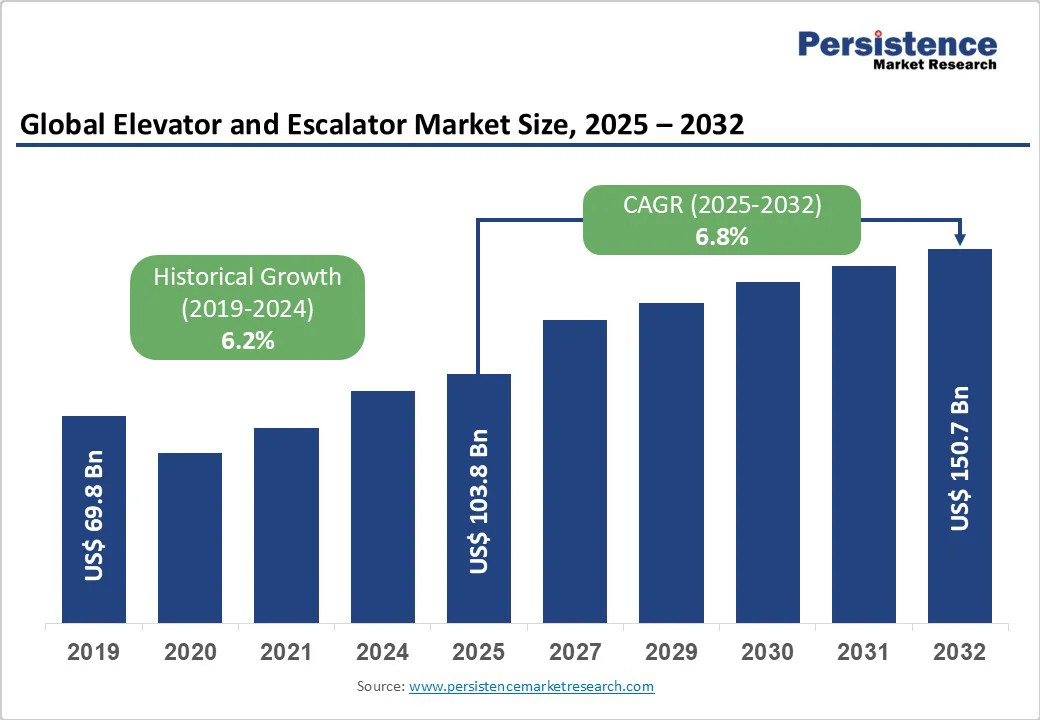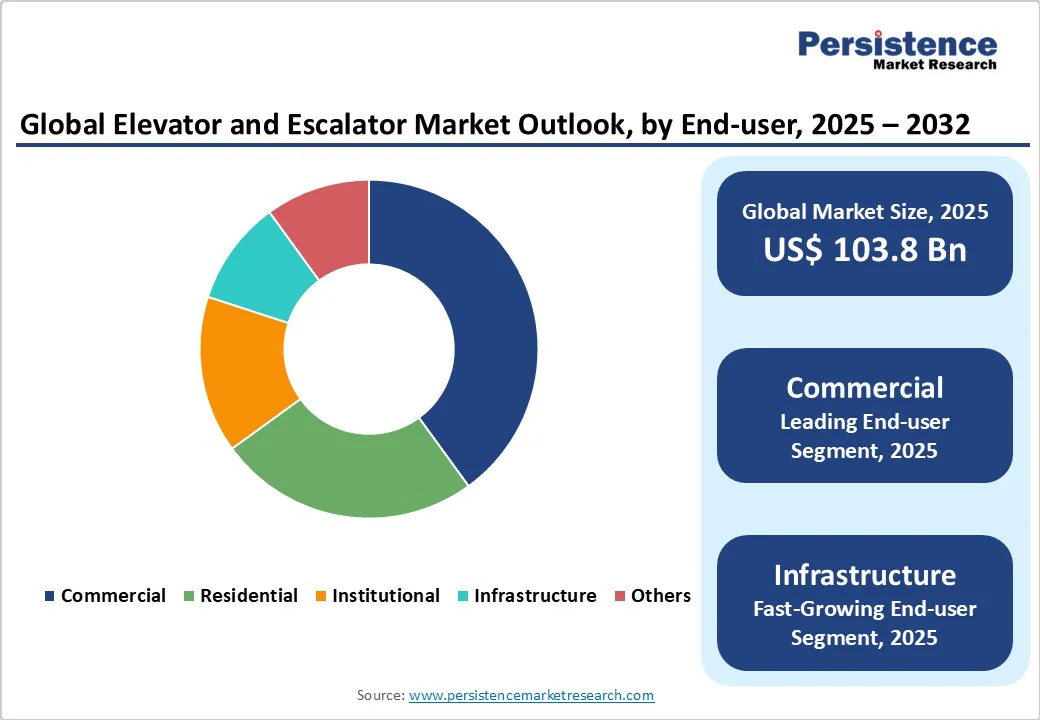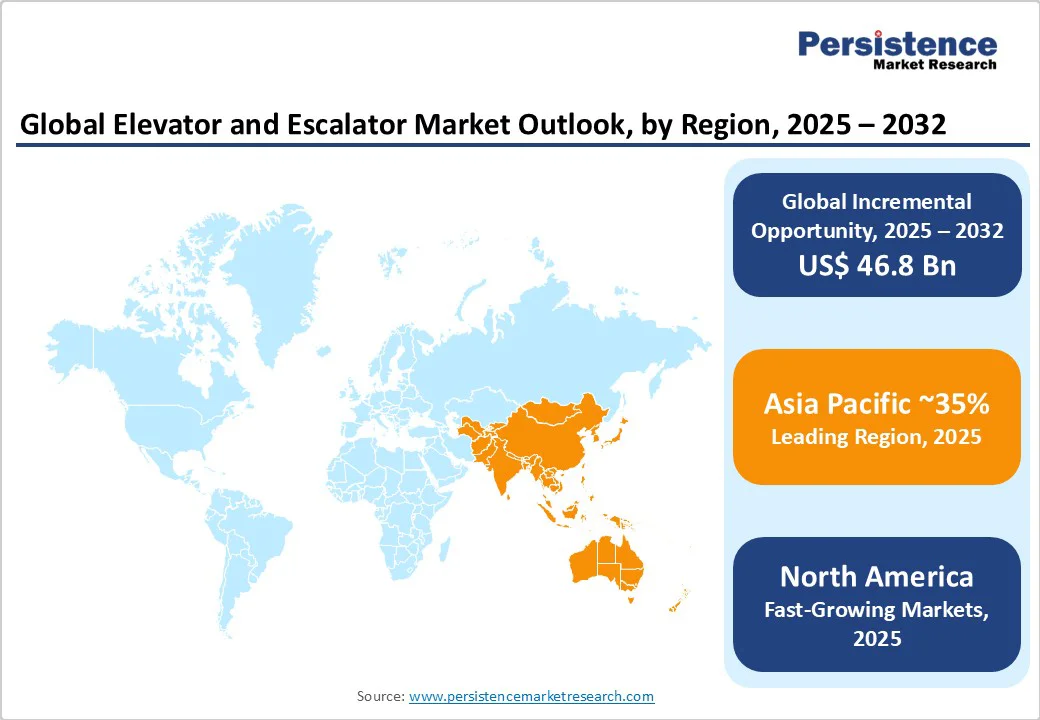ID: PMRREP34696| 177 Pages | 3 Oct 2025 | Format: PDF, Excel, PPT* | Industrial Automation

The global elevator and escalator market size is likely to be valued at US$ 103.8 billion in 2025 and is projected to reach US$ 150.7 billion by 2032, growing at a CAGR of 6.4% between 2025 and 2032. This trajectory is primarily driven by rapid urbanization with 68% of the global population expected to live in urban areas by 2050, and massive infrastructure investments exceeding US$2.16 trillion annually in construction spending.
| Key Insights | Details |
|---|---|
|
Elevator and Escalator Market Size (2025E) |
US$ 2.4 Bn |
|
Market Value Forecast (2032F) |
US$ 3.3 Bn |
|
Projected Growth (CAGR 2025 to 2032) |
6.4% |
|
Historical Market Growth (CAGR 2019 to 2024) |
5.8% |

Global urbanization trends are fundamentally driving elevator and escalator demand, with the United Nations projecting urban population growth from 55% in 2018 to 68% by 2050, adding approximately 2.5 billion people to urban areas. This massive demographic shift necessitates vertical infrastructure expansion, with countries like India targeting a 40.76% urban population by 2030 compared to 34.93% in 2020.
Infrastructure investment has reached unprecedented levels, with U.S. construction spending alone estimated at US$ 2.16 trillion in 2024, representing a 6.7% increase from 2023, while public construction spending rose to US$ 270.8 billion. Government initiatives including India's Smart Cities Mission targeting 100 smart cities and China's projected US$ 13 trillion building investment by 2030, are creating substantial market opportunities.
These urbanization patterns directly translate to increased demand for high-rise residential and commercial buildings, with India's commercial real estate sector absorbing 42 million square feet of office space in 2022 alone.
The integration of Internet of Things (IoT), artificial intelligence, and predictive maintenance technologies is revolutionizing the elevator and escalator industry. IoT-enabled smart elevator systems now provide real-time monitoring, remote diagnostics, and predictive maintenance capabilities, reducing downtime by up to 50% and improving operational efficiency by 30%. Advanced sensor networks collect data on vibrations, temperature fluctuations, noise levels, and acceleration patterns, enabling proactive maintenance scheduling and minimizing disruptions.
Smart elevator technology includes touchless controls, destination management systems, and energy optimization algorithms that reduce power consumption by 25-40%, aligning with green building initiatives and sustainability standards. The market for smart elevator solutions is expanding rapidly, with manufacturers investing heavily in digital platforms that enable predictive maintenance services and automated performance optimization.
The elevator and escalator market faces significant adoption challenges due to high initial investment requirements and complex technical integration. Installation costs often exceed US$ 50,000 for residential systems and surpass US$ 100,000 for luxury models, while retrofitting older buildings requires extensive structural modifications that can double project costs and cause 6–12 month delays. Furthermore, the growing reliance on smart technologies IoT sensors, AI platforms, and predictive maintenance demands specialized expertise, continuous software updates, and cybersecurity measures, raising annual ownership costs.
Limited IT and connectivity infrastructure in developing regions further restricts smart system adoption. These financial and technical hurdles reduce affordability, slow modernization efforts, and constrain market penetration, especially in cost-sensitive and infrastructure-limited economies.
Developing economies in Asia-Pacific, Latin America, and Africa present substantial growth opportunities driven by rapid urbanization, rising disposable incomes, and expanding middle-class populations. India's elevator and escalator market is projected to grow at 10.8% CAGR through 2029, reaching US$ 22.2 billion by 2033, driven by government initiatives and infrastructure development. China's building investment of US$ 13 trillion by 2030 creates unprecedented opportunities for vertical transportation solutions, while ASEAN countries are implementing new environmental regulations requiring modern elevator systems in commercial buildings.
The aging population demographic in developed markets creates additional opportunities for residential elevator installations, with homeowners seeking accessibility solutions for aging-in-place strategies. This demographic shift is particularly pronounced in North America and Europe, where residential elevator demand is driven by luxury home features and long-term convenience considerations.
The convergence of artificial intelligence, IoT, and predictive analytics creates opportunities for new service models and enhanced value propositions in the elevator industry. Predictive maintenance services enabled by machine learning algorithms can forecast component failures weeks in advance, enabling proactive repairs and minimizing downtime. The development of elevator-as-a-service models provides opportunities for recurring revenue streams through comprehensive maintenance, monitoring, and performance optimization services.
Integration with smart city infrastructure, including traffic management systems and emergency response networks, creates opportunities for elevator systems to contribute to broader urban mobility solutions. The expansion of vertical mobility applications beyond traditional buildings into transportation hubs, urban air mobility platforms, and specialized industrial applications represents emerging market segments with high growth potential.
Elevators Lead While Escalators and Walkways Drive Emerging Growth
Elevators dominate the global market with a 64% share. This segment includes passenger, freight, and specialized systems across residential, commercial, and industrial spaces. Market leadership stems from their critical role in high-rise buildings, wide adoption across sectors, and advancements such as machine-room-less designs and IoT-enabled smart controls.
Strong demand in Asia-Pacific, led by China’s skyscraper boom and India’s infrastructure push, further fuels growth. Escalators represent the fastest-growing product category, supported by metro expansions, airport upgrades, and retail development across emerging economies.
Demand is particularly strong in India and China, while modernization projects in developed markets drive replacement with energy-efficient and smart-enabled systems. Moving walkways complement this growth, serving airports and transit hubs with specialized passenger mobility solutions.
Traction Elevators Dominate While Machine Room-Less Systems Drive Rapid Growth
Traction elevators lead the technology segment with a 38.2% market share. Using steel ropes or belts with counterweights, these systems deliver superior speed, capacity, and energy efficiency compared to hydraulic alternatives, making them the preferred choice for high-rise applications such as office towers, residential skyscrapers, and mixed-use complexes. Continuous innovations, including gearless machines, regenerative drives, and smart control systems, further enhance performance and reduce energy use.
Complementing this dominance, Machine Room-Less (MRL) traction elevators represent the fastest-growing segment, driven by their space-saving design and flexible installation. By integrating components directly into the hoistway, MRL systems eliminate the need for a separate machine room, saving 20–35 square feet and lowering installation costs by 10–20%.
Commercial Applications Lead While Residential Segment Gains Strong Growth
Commercial applications dominate the elevator and escalator market with a 52.4% share in 2025. Their leadership reflects the indispensable role of vertical transportation in office towers, retail complexes, hospitals, and educational institutions. Strict building codes mandating elevator access, coupled with the need to handle high passenger volumes efficiently, reinforce demand.
Advanced features such as destination control, smart building integration, and high-capacity systems further strengthen adoption across global commercial hubs, particularly in regions witnessing strong real estate expansion. In contrast, residential applications represent the fastest-growing segment, driven by multi-family housing projects, luxury homes, and retrofitting for accessibility.
Technological innovations like compact machine-room-less elevators, energy-efficient designs, and aesthetic customization support adoption in homes. Growth is especially strong in Asia-Pacific high-rise housing developments and North American retrofit markets addressing accessibility and lifestyle needs.

North America accounts for an estimated 20% share of the global elevator and escalator market. The region’s large installed base of aging elevators and escalators presents significant opportunities for modernization, replacement, and service activities, projected to reach US$ 17.4 billion by 2030. Growth is supported by strict safety standards set by the American Society of Mechanical Engineers (ASME), accessibility compliance under the Americans with Disabilities Act (ADA), and heavy infrastructure investments exceeding US$ 2.16 trillion annually.
Increasing adoption of smart city initiatives further drives demand for advanced vertical transportation systems. Investment trends highlight modernization and IoT-enabled predictive maintenance, with Otis expanding its U.S. footprint in 2025 through eight Urban Elevator acquisitions. The competitive landscape is led by global giants Otis, Schindler, TK Elevator, KONE, and Mitsubishi Electric, emphasizing energy-efficient and connected elevator solutions.
Europe holds an estimated 15% share of the global elevator and escalator market, valued at about US$ 17.4 billion in 2025. Growth momentum is fueled by modernization needs, sustainability initiatives, and the region’s commitment to green building standards. Mature markets such as the UK and Germany report modest growth of around 1% annually, while emerging economies including Croatia, Georgia, Romania, and Ukraine show faster expansion.
EU-wide regulatory harmonization, covering safety, accessibility, and energy efficiency standards, ensures consistent requirements across member states. Demand is further reinforced by green building certification programs and extensive city-level modernization projects. Leading European players include KONE (Finland), Schindler (Switzerland), and TK Elevator (Germany), all advancing sustainable and modular design innovations.
Market opportunities center on smart building integration, IoT-based predictive maintenance, and eco-friendly technologies such as regenerative drives and recyclable materials, aligning with Europe’s carbon reduction and energy efficiency targets.
Asia-Pacific dominates the global elevator and escalator market with a 35.8% share. China remains the largest contributor, supported by projected building investments of over US$ 13 trillion by 2030, while India is set to grow at 6.8% CAGR to reach US$ 22.2 billion by 2032, driven by the Smart Cities Mission and large-scale housing programs such as Pradhan Mantri Awas Yojana.
The region benefits from cost-efficient manufacturing, strong supply chains, and favorable government policies. Market performance highlights include India’s commercial real estate growth, Japan’s IoT-based smart elevator advancements, and ASEAN nations’ green regulations mandating energy-efficient vertical transport. Investments prioritize high-rise residential projects, metro expansions, and smart city developments.

The global elevator and escalator market exhibits a moderately consolidated structure, with leading players holding approximately 40-45% combined market share, indicating established market leadership among top-tier manufacturers. Market concentration analysis reveals Otis Worldwide Corporation maintaining global leadership, followed by KONE Corporation (approximately 20% global market share), Schindler Group, TK Elevator (Germany), and Mitsubishi Electric Corporation representing the top five players.
This concentration reflects the industry's emphasis on technological innovation, global service networks, and substantial capital requirements for manufacturing and installation capabilities.
Competitive positioning varies by technology segment, with companies like KONE leading in smart elevator technology and eco-efficient solutions, while Schindler emphasizes modular designs and destination control systems, and Otis focuses on comprehensive modernization services and digital transformation.
The Elevator and Escalator market is estimated to be valued at US$ 103.8 Bn in 2025.
The key demand driver for the Elevator & Escalator market is rapid urbanization and soaring demand for high-rise/residential & commercial buildings, which necessitate efficient vertical transportation systems.
In 2025, the Asia Pacific region will dominate the market with an exceeding 35% revenue share in the global Elevator and Escalator market.
Among the Product Type, Elevators holds the highest preference, capturing beyond 64% of the market revenue share in 2025, surpassing other parts.
The key players in the Elevator and Escalator market KONE Corporation, Hitachi Ltd., Schindler Group, Otis, and TK Elevator.
| Report Attribute | Details |
|---|---|
|
Historical Data/Actuals |
2019 - 2024 |
|
Forecast Period |
2025 - 2032 |
|
Market Analysis Units |
Value: US$ Bn, Volume: Units |
|
Geographical Coverage |
|
|
Segmental Coverage |
|
|
Competitive Analysis |
|
|
Report Highlights |
|
By Product Type
By Technology Type
By End-user
By Service
By Region
Delivery Timelines
For more information on this report and its delivery timelines please get in touch with our sales team.
About Author